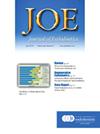使用 Penrose 引流管为大面积根尖周病变减压:随访 4.5 年的病例报告
IF 3.5
2区 医学
Q1 DENTISTRY, ORAL SURGERY & MEDICINE
引用次数: 0
摘要
治疗大型根尖囊肿样病变是一项巨大的挑战,尤其是在非手术治疗或再治疗方案无效的情况下。尽管减压术效果显著,但在现代牙科中仍是一种未得到充分利用的微创替代方法。本病例报告描述了在对一名 56 岁男性的上颌侧切牙进行抽吸和冲洗后,使用 Penrose 引流管进行减压,以处理与该患者上颌侧切牙相关的巨大根尖周病变。该病变导致面部和腭部皮质板以及鼻窝下缘变薄和穿孔。锥形束计算机断层扫描用于术前评估病变情况和术后评估愈合进度。在减压术后 3.5 年再次进行根端手术后,观察到了完全的三维愈合。该报告表明,在尝试非手术根管治疗无效的情况下,使用彭罗斯引流管减压并结合抽吸和冲洗,是治疗大型根尖周囊肿样病变的一种简单而有效的方法。本文章由计算机程序翻译,如有差异,请以英文原文为准。
Use of a Penrose Drain for Decompression of a Large Periapical Lesion: A Case Report With 4.5-Year Follow-up
Managing large cyst-like periapical lesions poses significant challenges, especially when nonsurgical treatment or retreatment options are ineffective. Despite its efficacy, decompression remains an underutilized minimally invasive alternative in modern dentistry. This case report describes the use of a Penrose drain for decompression following aspiration and irrigation to manage a large periapical lesion associated with a 56-year-old man's maxillary lateral incisor. The lesion had caused thinning and perforation of the facial and palatal cortical plates, as well as the inferior border of the nasal fossa. Cone-beam computed tomography was used to evaluate the lesion preoperatively and to assess the healing progress postoperatively. Complete 3-dimensional healing was observed after a subsequent root-end surgery performed 3.5 years post-decompression. This report suggests that decompression using a Penrose drain in combination with aspiration and irrigation could be a simple but effective modality for managing large cyst-like periapical lesions when nonsurgical endodontics are attempted and deemed ineffective.
求助全文
通过发布文献求助,成功后即可免费获取论文全文。
去求助
来源期刊

Journal of endodontics
医学-牙科与口腔外科
CiteScore
8.80
自引率
9.50%
发文量
224
审稿时长
42 days
期刊介绍:
The Journal of Endodontics, the official journal of the American Association of Endodontists, publishes scientific articles, case reports and comparison studies evaluating materials and methods of pulp conservation and endodontic treatment. Endodontists and general dentists can learn about new concepts in root canal treatment and the latest advances in techniques and instrumentation in the one journal that helps them keep pace with rapid changes in this field.
 求助内容:
求助内容: 应助结果提醒方式:
应助结果提醒方式:


